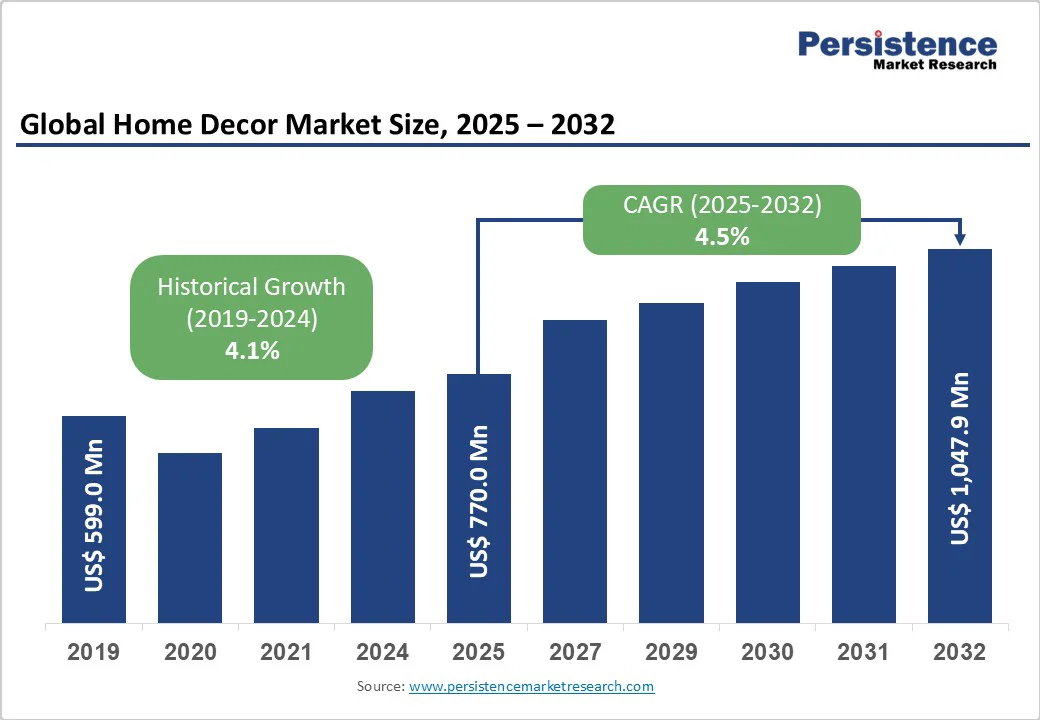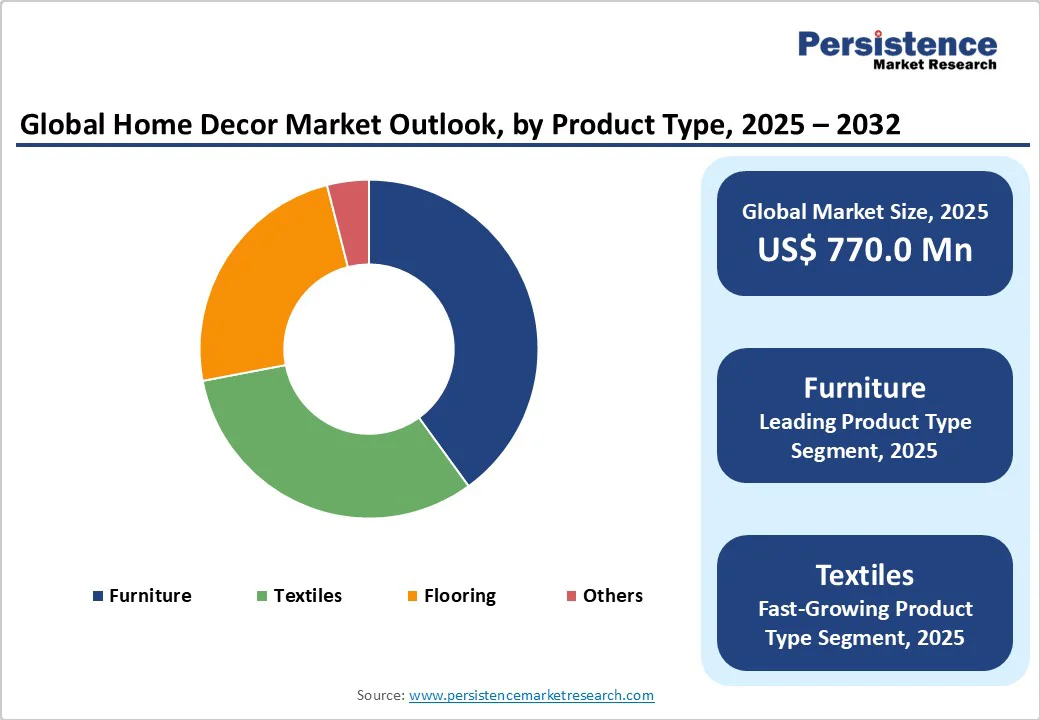ID: PMRREP33686| 195 Pages | 29 Sep 2025 | Format: PDF, Excel, PPT* | Consumer Goods

The global home decor market size is likely to be valued at US$770.0 Mn in 2025 and is expected to reach US$1,047.9 Mn by 2032, growing at a CAGR of 4.5% during the forecast period from 2025 to 2032. Rapid urbanization drives demand for functional, stylish, and space-efficient furnishings. Increasing consumer focus on sustainable, personalized, and smart décor, combined with the proliferation of e-commerce, boosts the popularity of home décor products.
| Key Insights | Details |
|---|---|
|
Home Decor Market Size (2025E) |
US$770.0 Mn |
|
Market Value Forecast (2032F) |
US$1,047.9 Mn |
|
Projected Growth (CAGR 2025 to 2032) |
4.5% |
|
Historical Market Growth (CAGR 2019 to 2024) |
4.1% |

Rising urbanization is a key driver of the home decor market as growing city populations create higher demand for modern and functional living spaces. With migration from rural to urban areas accelerating, households are increasingly investing in décor solutions that optimize smaller apartments and city homes. Modular furniture, multifunctional storage units, and aesthetic lighting are gaining traction as consumers seek both style and practicality. For instance, India’s urban population, which was 31% in 2011, is projected by government estimates to rise to nearly 40% by 2030, highlighting the scale of urban expansion and its influence on home improvement demand.
Alongside this, consumer expenditure patterns reveal a notable rise in discretionary spending. The latest Household Consumption Expenditure Survey released by the Ministry of Statistics & Programme Implementation shows a higher allocation toward non-food categories, including furnishings and household durables. This demonstrates consumers’ growing willingness to invest in home décor, strengthening the overall market growth.
The home décor market faces restraints due to the high costs associated with premium products. Luxury furniture, designer lighting, and sustainable décor materials often come with elevated price tags, limiting affordability for middle-income consumers. This price sensitivity restricts the broader adoption of high-end décor, particularly in emerging markets where discretionary spending is still developing. As a result, many households opt for budget-friendly alternatives, slowing the penetration of premium décor offerings.
Additionally, supply chain disruptions have emerged as a significant challenge. Global shortages of raw materials, rising freight charges, and delays in logistics increase production costs and affect timely product availability. Such disruptions not only reduce profit margins for manufacturers but also create fluctuations in product prices, hindering steady market growth.
The home décor market is witnessing strong opportunities with the rapid growth of e-commerce platforms. Online marketplaces and brand-owned websites have expanded consumer access to a wide variety of décor products, offering convenience, competitive pricing, and personalized shopping experiences. Digital channels also enable smaller brands and artisans to reach wider audiences, boosting sales and visibility. This shift is reshaping purchasing behavior, as more consumers now prefer browsing and buying décor items online rather than relying solely on offline retail.
In parallel, rising awareness of environmental concerns is driving demand for sustainable décor trends. Consumers increasingly favor eco-friendly materials, recycled furniture, and ethically sourced products. Brands adopting green manufacturing practices and promoting durability over disposability are aligning with consumer values, creating long-term opportunities for innovation and market expansion in sustainable home décor.
In 2025, furniture accounts for the largest share, accounting for nearly 40%. This dominance is driven by rising urban housing demand, increasing disposable income, and consumer preference for multifunctional and space-saving designs. Furniture remains a central investment in households, covering essentials such as sofas, beds, dining sets, and modular storage. Premium offerings, including smart and sustainable furniture, further strengthen this segment’s growth.
Textiles are emerging as the fastest-growing category. Demand for curtains, rugs, cushions, and upholstery is surging as consumers focus on personalization and seasonal updates to enhance interiors. Growing interest in sustainable fabrics and vibrant designs is also fueling this trend, making textiles a dynamic driver of future home décor market expansion.
In 2025, the indoor segment dominates the home décor market with nearly 70% share, reflecting the strong demand for furniture, lighting, textiles, and decorative items that enhance interiors. Consumers continue to prioritize comfort, functionality, and aesthetics in their living spaces, especially with rising urbanization and smaller homes requiring smart indoor décor solutions. The shift toward premium and customized indoor décor products also contribute to the segment’s leading position.
The outdoor segment is projected to be the fastest-growing. Increasing interest in patios, balconies, and garden spaces is driving demand for outdoor furniture, lighting, and decorative accessories. Lifestyle changes, growing emphasis on leisure at home, and the popularity of sustainable, weather-resistant designs are accelerating this segment’s rapid growth

In 2025, North America is projected to hold a 38% share, establishing itself as the leading region. This dominance is driven by strong consumer purchasing power, advanced housing infrastructure, and rising demand for premium and customized décor solutions. The region further benefits from widespread e-commerce adoption, a mature retail network, and a culture of frequent home renovations and remodeling. Growing interest in sustainable and smart décor, supported by the presence of established global brands, continues to fuel growth. Together, these factors reinforce North America’s position as the largest contributor to the industry.
Europe holds a significant share, supported by strong design heritage, high consumer preference for premium interiors, and a growing shift toward sustainable living. The region benefits from established retail and e-commerce networks, alongside government initiatives promoting eco-friendly products and energy-efficient housing solutions. Rising demand for stylish furniture, textiles, and innovative décor items is further enhanced by consumers’ focus on quality and durability. Additionally, increasing renovation and remodeling activities across key countries such as Germany, France, and the UK continue to drive demand. These factors collectively position Europe as a vital contributor to the industry’s overall growth and innovation.
Asia Pacific is emerging as the fastest-growing region, fueled by rapid urbanization, rising disposable incomes, and expanding middle-class populations. Growing housing demand and lifestyle shifts are encouraging consumers to invest more in modern and functional décor solutions. The region also benefits from a thriving e-commerce ecosystem, which is making a wide variety of products more accessible across urban and semi-urban areas. Increasing awareness of sustainable and affordable options, coupled with strong demand in countries such as China, India, and Southeast Asian nations, further accelerates growth. These dynamics position the Asia Pacific as a key driver of future industry expansion.

The global home décor market is driven by changing consumer preferences, urbanization, and increased focus on both functional and stylish living spaces. The competitive landscape features established brands, regional producers, and new entrants emphasizing innovation, sustainability, and diversified product offerings. Expanding e-commerce channels have improved accessibility and heightened competition across markets. Growing demand for premium, personalized, and cost-effective décor solutions is prompting companies to implement distinct strategies, strengthening their market presence and supporting the sector’s long-term growth potential.
The home decor market is projected to reach US$770.0 Mn in 2025, driven by home improvement and e-commerce trends.
Urbanization, rising disposable incomes, and demand for sustainable decor fuel market growth.
The home decor market will grow from US$770.0 Mn in 2025 to US$1,047.9 Mn by 2032, with a CAGR of 4.5%.
E-commerce growth and sustainable decor trends drive opportunities in indoor and outdoor applications.
Leading players include IKEA, The Home Depot, Williams-Sonoma, Inc., Wayfair, Ethan Allen, Crate and Barrel, Bed Bath and Beyond, Ashley Furniture Industries, Anthropologie, Surya, and Z Gallerie.
| Report Attribute | Details |
|---|---|
|
Historical Data/Actuals |
2019 - 2024 |
|
Forecast Period |
2025 - 2032 |
|
Market Analysis |
Value: US$ Mn, Volume: As Applicable |
|
Geographical Coverage |
|
|
Segmental Coverage |
|
|
Competitive Analysis |
|
|
Report Highlights |
|
By Product Type
By Application
By Region
Delivery Timelines
For more information on this report and its delivery timelines please get in touch with our sales team.
About Author